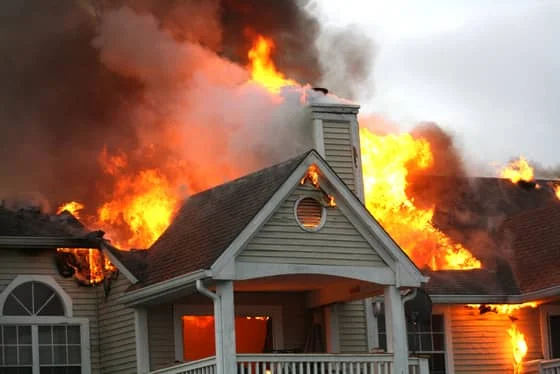A frequent site of home fires is the patio or deck. If your outside space has been damaged by fire and selling a fire-damaged house is not yet an option you want to consider, here are some tips to keep in mind when replacing it.
Basic steps for patio construction
There are six basic areas that you will want to address to ensure to maximize the beauty and effectiveness of the new patio you are building to replace your fire-damaged deck. Those areas are:
Design and Planning –
What materials will you use? Will there be curves, a medallion, benches or other structural features? Do you need to remove an existing patio, extend it, or remove sod? Will there be some kind of enclosure or fencing for privacy?

Estimating Costs and Time to Construct –
Simple formulas and information can help you determine how much time and money it will take to turn your dream into reality.
Preparing a Materials List –
This includes tools. Will you need to rent a tamper? Does your design involve curves and cut pavers?
Site Preparation –
Mapping out the space, leveling the ground and installing foundation materials are key here.
Laying the Patio –
Things to consider include patterns you can create using different materials. Techniques and finishing touches the pros know all about but that you can use as well. Avoiding common mistakes and pitfalls.
Finishing Off –
Depending on the type of patio, there may be finishing work such as filling in lines with mortar or dry sand fill and sealing and treating the finished surface.
Now let’s take a closer look at the first step so that you can get your replacement project started off on the right foot.
To ensure success, plan it out
Getting started on a replacement for a fire-damaged patio is as easy as deciding to do the job. Having the resolve to roll up your sleeves and get to work is what is needed to complete it.
With ideas from others, your local home center, and an evaluation of what you want for your patio space, you are ready to begin the first step of designing and planning your patio.
“Measure twice, cut once”
That’s an old carpenter’s adage and it applies very well to a new patio project.
By having everything planned out well ahead of the time you actually start building you will save yourself many unnecessary trips to the home and garden center or quarry.
Preparation also means fewer surprises when it comes to costs and the amount of time it takes to create your patio.
Planning and preparing saves many headaches even years down the road. With proper preparations made, your patio will require less maintenance and fewer repairs, too.
Planning out the design
One of the best ways to choose a design without having to hire a professional is to just look around.
See what the neighbors have done. Drive around and look at other yards.
Visit the stone and brick sales center for pictures and what materials are available.
Styles, and patterns for laying down the materials, are usually on display.
There are also numerous websites that you can visit online that show different styles and materials for building a patio. There are also kits available that fit together like numbered puzzles to create features that add interest to a patio design.
See if one of these, such as a circular medallion, fits the style you want to replace your fire-damaged deck.
In considering your design you should ask yourself the following questions:
What will I use the patio for?
Is it in the front or back of the house?
How much furniture do I want to put on it?
Will the patio house the grill or an entire outdoor kitchen work island?
Do I want to include a fire pit?
Will the style I like look good with my house color and style?
Will the materials I like hold up during the winter weather?
What kind of maintenance am I willing to do?
Planning out the size
A measuring guide can help you determine if you have chosen a size that is right for your needs.
Experts suggest you go a little bigger than you think you need. It might sound like a large patio if you’ve settled on an 8’x 10’ size, but translate that into a room size and you will soon realize it is very small especially if you plan to place any furniture on your patio.
Although a patio doesn’t have walls to visually close it in, you want to plan on enough floor space for all of your outdoor furnishings with enough room to move around as well.
So think in terms of your patio being a room to be furnished and your measurements will not leave you coming up short on space.
Also, think about what uses you may want for the patio years down the road, since a patio is a semi-permanent structure.
One approach to measuring may seem a little backwards, but it helps minimize the number of cuts you need to make when laying your materials.
Here’s how to do it:
If you decided on a brick patio with standard sized brick pavers, you can lay perpendicular rows of bricks to the width and length you want your patio.
If a brick is 3” wide with a 3/8” space between each, and you want to have a patio that is approximately 12 feet wide (144”), you will have a row of 43 bricks (144” divided by 3.375” for the brick plus mortar space).
For a length of 15 feet (180”) using the 3” wide by 6” long brick you would lay out 28 bricks end to end with mortar space to equal approximately 15 feet.
Your patio measurement won’t be exactly 12’ x 15’ but close to that dimension and exact enough that you won’t end up cutting small pieces of brick to fit the ends.
The visual effect and space available on the patio will be within that 12’ by 15’ measurement.
The good news about measuring a patio using brick or natural materials is that it is not an exact science. You can start at your house edge and go out to the approximate length you want. If you end up with a small space and don’t want to cut additional materials to fill it in, you can back fill your soil and re-grow grass or put other plantings to finish the space. Additionally, you can go one brick larger into the yard so that you end your patio with an uncut complete looking edge.
Follow these tips to ensure your new patio project gets off on the right foot.
Want to sell your fire-damaged house?
If your house has been severely damaged in a house fire and you are thinking of selling a fire-damaged house, We Buy Fire Damaged Houses buys burned homes in as is condition. We also pay all cash so you can get your money fast. Complete the short form below to see if your house qualifies for a free quote.
Photo by Im3rd Media on Unsplash

